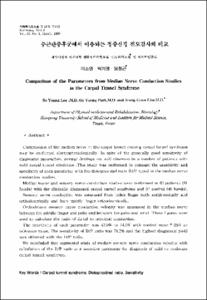수근관증후군에서 이용되는 정중신경 전도검사의 비교
- Keimyung Author(s)
- Lee, So Young; Park, Gi Young; Lim, Jeong Geun
- Department
- Dept. of Rehabilitation Medicine (재활의학)
Dept. of Neurology (신경과학)
Institute for Medical Science (의과학 연구소)
- Journal Title
- Keimyung Medical Journal
- Issued Date
- 1999
- Volume
- 18
- Issue
- 1
- Abstract
- Compression of the median nerve in the carpal tunnel causing carpal tunnel syndrome may be confirmed electrophysiologically. In spite of the generally good sensitivity of diagnostic parameters, normal findings are still observed in a number of patients with mild carpal tunnel syndrome This study was performed to compare the sensitivity and specificity of each parameter with the distoproximal ratio (D/P ratio) in the median nerve conduction studies.
Median motor and sensory nerve conduction studies were performed in 63 patients (81 hands) with the clinically diagnosed carpal tunnel syndrome and 32 control (46 hands).
Sensory nerve conduction was measured from index finger both antidromically and orthodromically and from middle finger orthodromically.
Orthodromic sensory nerve conduction velocity was measured in the median nerve between the middle finger and palm and between the palm and wrist. These figures were used to calculate the ratio of distal to proximal conduction.
The sensitivity of each parameter was 47.0% to 74.2% with control mean±2SD as reference value. The sensitivity of D/P ratio was 74.2% and the highest diagnostic yield was obtained with the D/P ratio.
We concluded that segmental study of median sensory nerve conduction velocity with calculation of the DIP ratio is a sensitive parameter for diagnosis of mild to moderate carpal tunnel syndrome.
- Alternative Title
- Comparison of the Parameters from Median Nerve Conduction Studies in the Carpal Tunnel Syndrome
- Publisher
- Keimyung University School of Medicine
- Citation
- 이소영 et al. (1999). 수근관증후군에서 이용되는 정중신경 전도검사의 비교. Keimyung Medical Journal, 18(1), 126–133.
- Type
- Article
- 파일 목록
-
-
Download
 18-126.pdf
기타 데이터 / 396.67 kB / Adobe PDF
18-126.pdf
기타 데이터 / 396.67 kB / Adobe PDF
-
Items in Repository are protected by copyright, with all rights reserved, unless otherwise indicated.